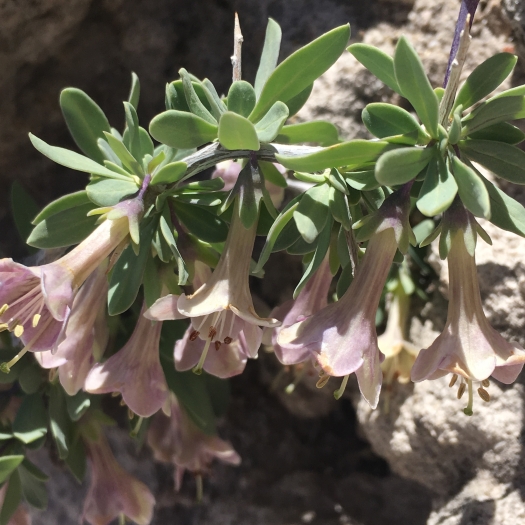Pale Desert-Thorn
(Lycium pallidum)
Pale Desert-Thorn (Lycium pallidum)
/
/

Harry Podschwit
CC BY 4.0
Image By:
Harry Podschwit
Recorded By:
Copyright:
CC BY 4.0
Copyright Notice:
Photo by: Harry Podschwit | License Type: CC BY 4.0 | License URL: http://creativecommons.org/licenses/by/4.0/ | Rights Holder: Harry Podschwit | Publisher: iNaturalist | Date Created: 2019-05-03T20:30:42Z |







































































Estimated Native Range
Summary
Lycium pallidum, commonly known as Pale Desert-Thorn, is a deciduous shrub native to arid and semi-arid regions including deserts, grasslands, and scrublands in the Southwestern USA and Northern Mexico. It typically grows to a height of 1–3 meters (3 ft 3 in – 9 ft 10 in) and is characterized by a dense tangle of spiny, spreading, or erect branches that can form bushy thickets. The leaves are small, fleshy, and pale green, which helps to reflect sunlight and conserve water. The flowers, which bloom from late spring to early summer, are solitary or borne in pairs, funnel-shaped, and range in color from creamy-yellow to yellowish-green, sometimes tinged with purple. They are fragrant and attract a variety of insect pollinators. Following pollination, the plant produces juicy, oval-shaped, shiny red berries that are a food source for wildlife and can contain up to 50 seeds each.
Pale Desert-Thorn is valued for its drought tolerance and ability to thrive in challenging environments, making it suitable for xeriscaping and naturalistic plantings in arid regions. It can serve as an informal hedge or barrier due to its spiny branches. This shrub is low-maintenance, requiring minimal water once established and preferring well-drained soils. It is tolerant of a range of soil types, from sandy to loamy, as long as they provide good drainage. Full sun is ideal for optimal growth and flowering. Gardeners should be aware that while it is not typically prone to diseases, it can become invasive if conditions allow for unchecked spread through suckering and layering.CC BY-SA 4.0
Pale Desert-Thorn is valued for its drought tolerance and ability to thrive in challenging environments, making it suitable for xeriscaping and naturalistic plantings in arid regions. It can serve as an informal hedge or barrier due to its spiny branches. This shrub is low-maintenance, requiring minimal water once established and preferring well-drained soils. It is tolerant of a range of soil types, from sandy to loamy, as long as they provide good drainage. Full sun is ideal for optimal growth and flowering. Gardeners should be aware that while it is not typically prone to diseases, it can become invasive if conditions allow for unchecked spread through suckering and layering.CC BY-SA 4.0
Plant Description
- Plant Type: Shrub
- Height: 6-6 feet
- Width: 2-4 feet
- Growth Rate: Moderate
- Flower Color: Purple
- Flowering Season: Spring
- Leaf Retention: Deciduous
Growth Requirements
- Sun: Full Sun
- Water: Low, Medium
- Drainage: Fast, Medium
Common Uses
Bee Garden, Bird Garden, Butterfly Garden, Edible*Disclaimer: Easyscape's listed plant edibility is for informational use. Always verify the safety and proper identification of any plant before consumption., Erosion Control, Hummingbird Garden, Low Maintenance, Showy Flowers
Natural Habitat
native to arid and semi-arid regions including deserts, grasslands, and scrublands in the Southwestern USA and Northern Mexico
Other Names
Common Names: Pale Wolfberry
Scientific Names: , Lycium pallidum, Lycium pallidum var. pallidum,
GBIF Accepted Name: Lycium pallidum Miers